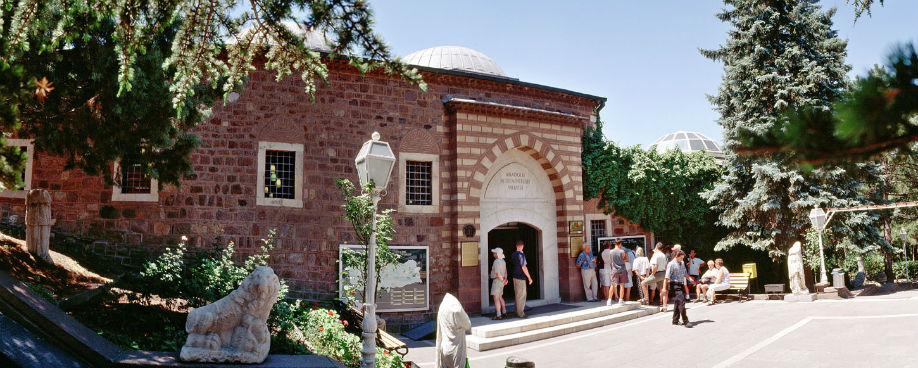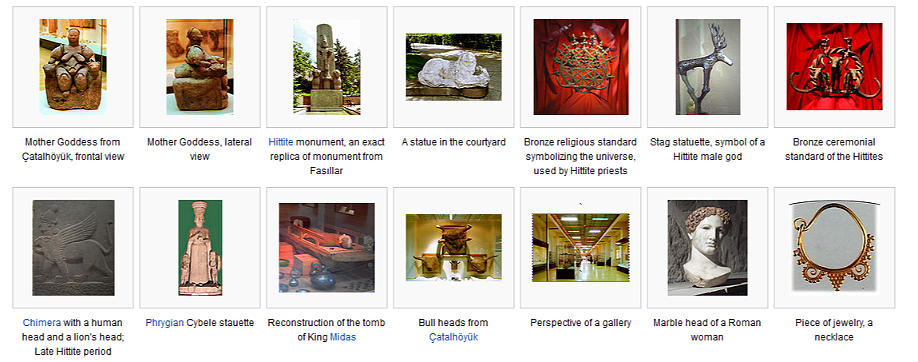The superb Museum of Anatolian Civilisations is the perfect introduction to the complex weave of Turkey’s ancient past, housing artefacts cherry-picked from just about every significant archaeological site in Anatolia.
The museum is housed in a beautifully restored 15th-century bedesten (covered market). The 10-domed central marketplace houses reliefs and statues, while the surrounding hall displays exhibits from the earlier Anatolian civilisations: Palaeolithic, Neolithic, Chalcolithic, Bronze Age, Assyrian, Hittite, Phrygian, Urartian and Lydian. The downstairs sections hold classical Greek and Roman artefacts and a display on Ankara’s history. Get there early to avoid the flood of tour groups and school parties.
The exhibits are chronologically arranged in a spiral: start at the Palaeolithic and Neolithic displays in the room to the right of the entrance, then continue in an anticlockwise direction, visiting the central room last.
Items from one of the most important Neolithic sites in the world Çatalhöyük, southeast of Konya – are displayed here. There’s a mock-up of the inside of a dwelling typical of those uncovered at the site, one of the most famous mother goddess sculptures unearthed from the excavations and wall paintings of hunting scenes.
Also on show are many finds from the Assyrian trading colony Kültepe, one of the world’s oldest and wealthiest bazaars. These include baked-clay tablets found at the site, which dates to the beginning of the 2nd millenium BC.
One of the striking Hittite figures of bulls and stags in the next room used to be the emblem of Ankara. The Hittites were known for their relief work, and some mighty slabs representing the best pieces found in the country, generally from around Hattuşa, are on display in the museum’s central room.
Most of the finds from the Phrygian capital Gordion, including incredible inlaid wooden furniture, are on display in the museum’s last rooms. The exhibits also include limestone blocks with still-indecipherable inscriptions resembling the Greek alphabet, and lion- and ram-head ritual vessels that show the high quality of Phrygian metalwork.
Urartian artifacts are also on display here. Spurred by rich metal deposits, the Urartians were Anatolia’s foremost metalworkers, as the knives, horse-bit, votive plates and shields on display demonstrate. There are also terracotta figures of gods in human form, some revealing their divine powers by growing scorpion tails, and neo-Hittite artefacts.
Downstairs, classical-period finds and regional history displays provide a local picture. Excavations have unearthed a Roman road near the Column of Julian, and Ankara has its own ‘missing link’, the 9.8-million-year-old Ankarapithecus (a 30kg, fruit-eating primate).




Being under renovation, I was disappointed in not seeing the Greek and Roman periods, but the artifacts from the earlier civiliations were well worth the trip. I was especially impressed with the early Paleolithic articles.
The museum is in an interesting old building and is just the right size not to tire or overwhelm a visitor.
I knew that Anatolia was rich in history and culture but I could only see how rich and historical it was when ı went to this museum.
Learned about civilisation I had never heard of before. Amazing jewelry, unbelieivable delicate. Definitely visit, eventhough part of the museum is still closed.
We visited the museum with our 3 boys (ages 8, 4 and 4) and we all liked it. Unfortunately, 2 of the 4 rooms are currently closed for renovation, which is too bad for us because we loved the half we did see and would have liked to visit the rest.
you will find out every thing about turkey history in this museum and also it is very good place to buy some gift for your friends .
My wife and I spent 2 days in Ankara for the purpose of seeing this museum. We were in the middle of a month visit to Turkey, for business but also to explore the culture and prehistory. We were not disappointed. The museum is the best we found in Turkey, and we DO museums. It starts with Catal Huyuk and…
When our group visited the Anatolian Civilizations Museum in October, approximately one half of the museum was being renovated. Some of the items from that half were moved to the half that was open. One should spend some time looking at the various statues that are outside of the museum, as well as the excellent map(s) on the wall–for use…
The Museum of Anatolian Civilizations has a splendid collection of artifacts beginning with neolithic peoples and extending through the late Hittite period (around 700 BC.) Unfortunately nearly half the museum is currently closed for renovation so the existing displays are more limited than they'd normally be and there's nothing on display after 700 BC.
Still, the museum is well worth…
Nice place to visit. Amazing architecture and attention to detail are all over this amazing building. What's even more impressive is its history; this masterpiece of human achitecture can not be missed !
Much of the museum was closed to the public for renovation. What was on display was excellent though. The Istanbul Archelogogical Museum beats this one hands down though so if you only have time to visit one then make it Istanbul.